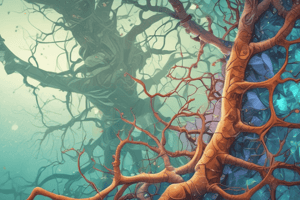Podcast
Questions and Answers
What is the branch of biology that studies the interactions between organisms and their environment?
What is the branch of biology that studies the interactions between organisms and their environment?
- Microbiology
- Zoology
- Ecology (correct)
- Botany
What is the main function of the nucleus in a cell?
What is the main function of the nucleus in a cell?
- To generate energy for the cell
- To store genetic information (correct)
- To regulate cell growth
- To synthesize proteins
What is the process by which organisms that are best adapted to their environment are more likely to survive and reproduce?
What is the process by which organisms that are best adapted to their environment are more likely to survive and reproduce?
- Speciation
- Artificial Selection
- Natural Selection (correct)
- Genetic Drift
What is the term for the community of living and non-living things interacting in an environment?
What is the term for the community of living and non-living things interacting in an environment?
What is the molecule that contains the genetic information in an organism?
What is the molecule that contains the genetic information in an organism?
What is the term for the process by which a new species emerges from an existing one?
What is the term for the process by which a new species emerges from an existing one?
Study Notes
Branches of Biology
- Botany: study of plants
- Zoology: study of animals
- Microbiology: study of microorganisms (bacteria, viruses, fungi)
- Ecology: study of interactions between organisms and their environment
- Genetics: study of heredity and variation
- Biochemistry: study of chemical processes in living organisms
- Molecular Biology: study of structure and function of biomolecules (DNA, proteins, etc.)
Cell Biology
- Cell: basic unit of life
- Cell membrane: semi-permeable membrane that surrounds the cell
- Cytoplasm: jelly-like substance inside the cell membrane
- Nucleus: contains genetic material (DNA)
- Organelles: specialized structures within the cell (mitochondria, ribosomes, etc.)
Genetics
- DNA (Deoxyribonucleic acid): molecule that contains genetic information
- Genes: segments of DNA that code for specific traits
- Chromosomes: thread-like structures that carry genes
- Traits: characteristics of an organism (eye color, height, etc.)
- Heredity: passing of traits from parents to offspring
Evolution
- Theory of Evolution: explains how species change over time
- Natural Selection: process by which organisms that are best adapted to their environment are more likely to survive and reproduce
- Speciation: process by which a new species emerges from an existing one
- Fossil Record: evidence of past life on Earth
Ecosystems
- Ecosystem: community of living and non-living things interacting in an environment
- Biotic factors: living components of an ecosystem (plants, animals, etc.)
- Abiotic factors: non-living components of an ecosystem (water, sunlight, etc.)
- Energy flow: energy is transferred from one organism to another through food chains and webs
Branches of Biology
- Botany focuses on the study of plants
- Zoology is concerned with the study of animals
- Microbiology explores the world of microorganisms, including bacteria, viruses, and fungi
- Ecology examines the interactions between organisms and their environment
- Genetics delves into the study of heredity and variation
- Biochemistry investigates the chemical processes in living organisms
- Molecular Biology examines the structure and function of biomolecules, such as DNA, proteins, and others
Cell Biology
- Cells are the basic units of life
- Cell membranes are semi-permeable, surrounding the cell
- Cytoplasm is a jelly-like substance inside the cell membrane
- The nucleus contains genetic material in the form of DNA
- Organelles are specialized structures within the cell, including mitochondria, ribosomes, and others
Genetics
- DNA is a molecule that contains genetic information
- Genes are segments of DNA that code for specific traits
- Chromosomes are thread-like structures that carry genes
- Traits are characteristics of an organism, such as eye color, height, and others
- Heredity refers to the passing of traits from parents to offspring
Evolution
- The Theory of Evolution explains how species change over time
- Natural Selection is the process by which organisms that are best adapted to their environment are more likely to survive and reproduce
- Speciation is the process by which a new species emerges from an existing one
- The Fossil Record provides evidence of past life on Earth
Ecosystems
- An ecosystem is a community of living and non-living things interacting in an environment
- Biotic factors include living components of an ecosystem, such as plants, animals, and others
- Abiotic factors include non-living components of an ecosystem, such as water, sunlight, and others
- Energy flow occurs through food chains and webs, where energy is transferred from one organism to another
Studying That Suits You
Use AI to generate personalized quizzes and flashcards to suit your learning preferences.
Description
Explore the different branches of biology, including botany, zoology, and microbiology, and delve into the basics of cell biology, including cell structure and function.




